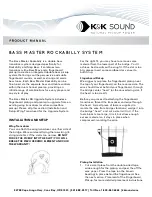
2
2.
Peel off the brown paper to leave the thin
adhesive layer on the wood. Press the pickup
onto the adhesive. (Note: Never remove the
pickup by pulling on the wire. Carefully use a
thin blade to pry it off.)
3.
You may want to use masking tape to secure the
wire along the back of the fingerboard while
you’re settling into the final position for the
pickup.
4.
Once you’re ready for permanent installation,
tack the wire to the remaining double-sided
tape, taking care that it is firmly adhered and
there is no possibility of it vibrating or buzzing
against the fingerboard.
Placement of the Fingerboard Pickup
The fingerboard transducer delivers a very different
tonal character and resonant depth depending on its
placement. Fingerboard backside construction
varies, but most are squared off at the neck joint,
and then scooped out as the fingerboard continues.
The sound changes character as you move from the
solid section of the fingerboard towards the thinner,
hollowed out areas. The pickup's edges are cut to
allow flat placement in any location as the
fingerboard profile changes.
You are strongly encouraged to experiment with
placement at various thickness near the top of the
fingerboard, in order to produce the type of tonal
response that you desire. Sufficient double-sided
tape is included so that you can move the
transducer to a different location, listen, and move it
again.
PREAMP SETUP & SOUND ADJUSTMENT
Snap off the preamp lid and insert a 9-volt battery.
You do not need to remove any screws, the lid
simply snaps off.
Important: Please do not tamper
with the screw on the bottom of the preamp!
You will find that the wing transducer has a higher
output than the fingerboard transducer, so we
recommend that you begin by reducing the internal
gain trimpot for the wing transducer (Channel 2) to
minimum, and adjust the fingerboard transducer
(Channel 1) gain trimpot to maximum; this can be
fine tuned later.
We also suggest that you begin with your
amplification system set flat, and proceed by
adjusting the internal bass and treble controls one
channel at a time, with the external volume for the
other completely off. Since each channel has a +/
20dB range, minor adjustments have a great effect
on the sound. Make changes very gradually.
Once each channel has been individually adjusted
to your preference, they can be blended using the
external volume controls. You may wish to leave
the preamp open to continue making adjustments, to
fine tune each channel's bass, treble, and gain
controls, as well as your amplification system, to
achieve the response you prefer.
Channel 1: Wing Transducer
Channel 2: Fingerboard Transducer
Unplug the output cable at the preamp when not in
use to conserve battery power.
TECHNICAL DATA
Wing: 22 mm diameter, 4 mm thick
Fingerboard: 12.5 (two edges trimmed), 0.7 mm
thick
Preamp: 3" x 3.5" x 1 "
Input Impedance: I Mega Ohm (each channel)
Output Impedance: I0 Kilo Ohms
Input: Stereo
¼
” Output: Mono
¼
”
Cable: 6 foot,
¼
” stereo plugs
Power: 9-volt battery (not included)




















